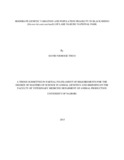| dc.description.abstract | The black rhino (Diceros bicornis) is critically endangered. Consequently, the species is managed in
parks and is often translocated to expand their range into areas where they have been extirpated.
Management of genetic variation has been identified as an important consideration in long-term
conservation strategies for many wild species including black rhino. In this study I aimed at determining
the extinction risk for the black rhino in Lake Nakuru National Park, Kenya so as to provide information
that can be incorporated into management decisions to improve the long-term viability and persistence of
the population.
Sixteen individuals from Lake Nakuru National Park subpopulations were randomly sampled for
this study. General standard molecular methods were employed. Genetic information was
obtained from 572 base pair mitochondrial D-loop sequences; a population viability analysis was
also conducted using quantitative data of black rhino from Lake Nakuru National Park.
The Mitochondrial DNA marker (572bp) revealed 13 polymorphic sites and 6 haplotypes. Only
two haplotypes (Hap1 and Hap 2) were shared by the sampled individuals, the marker detected a
moderate genetic diversity (h=0.742±0.084) and a relatively lower nucleotide diversity (π=
0.0079 ± 0.0008).
The population viability analysis baseline simulations showed that Lake Nakuru National Park
black rhino has a 0.00 probability of extinction during the next 75 years. However, continuing
threats make this subpopulation highly vulnerable to any change. Sensitivity simulations of
anthropogenic impacts showed that small increases in habitat loss (2%) and population decline. However, the need for conservation actions focused on preventing poaching, modulating
translocation program and promoting the conservation of available habitat is imperative. | en_US |

